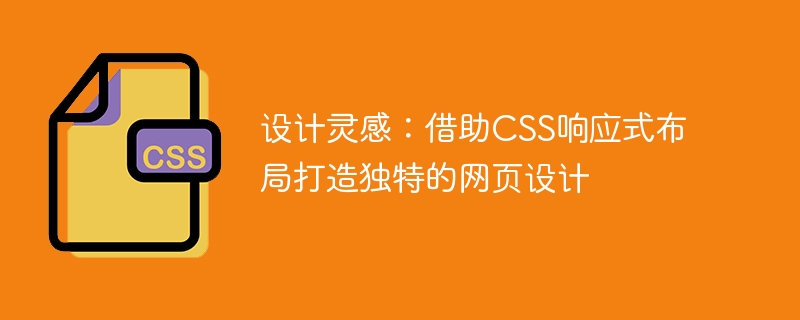

Design inspiration: Use CSS responsive layout to create a unique web design
In today's Internet era, web design has become an essential skill for various companies and individuals . Among many designs, with the help of CSS responsive layout, our web pages can be presented in the best layout on different devices, providing users with a better experience.
The principle of CSS responsive layout is to detect the screen size of the device through media queries and make corresponding adjustments. Below I will show you some amazing web designs, along with actual code examples, hoping to inspire you.
The navigation bar is an important part of the web page. We can realize the adaptive navigation bar through CSS media queries. Here is a simple sample code:
<!DOCTYPE html>
<html>
<head>
<style>
@media screen and (max-width: 600px) {
.nav {
display: none;
}
.nav-responsive {
display: block;
}
}
</style>
</head>
<body>
<div class="nav">
<ul>
<li><a href="#">首页</a></li>
<li><a href="#">产品</a></li>
<li><a href="#">关于我们</a></li>
<li><a href="#">联系我们</a></li>
</ul>
</div>
<div class="nav-responsive">
<select>
<option value="#">首页</option>
<option value="#">产品</option>
<option value="#">关于我们</option>
<option value="#">联系我们</option>
</select>
</div>
</body>
</html>In the above code, when the screen width is less than 600px, the navigation bar will be hidden and a drop-down menu will be displayed.
In web design, the importance of images is self-evident. Of course, in order to make the image render well on different devices, we can use the max-width attribute of CSS to limit the maximum width of the image, and height: auto to implement the adaptive image. high. The following is a simple sample code:
<!DOCTYPE html>
<html>
<head>
<style>
img {
max-width: 100%;
height: auto;
}
</style>
</head>
<body>
<img src="image.jpg" alt="示例图片">
</body>
</html> Grid layout is a common web page layout method that can divide web page content into different rows and columns. In responsive layout, we can use the flexbox property of CSS to implement adaptive grid layout. The following is a simple sample code:
<!DOCTYPE html>
<html>
<head>
<style>
.container {
display: flex;
flex-wrap: wrap;
}
.item {
flex-basis: 33.33%;
}
@media screen and (max-width: 600px) {
.item {
flex-basis: 50%;
}
}
</style>
</head>
<body>
<div class="container">
<div class="item">内容1</div>
<div class="item">内容2</div>
<div class="item">内容3</div>
</div>
</body>
</html>In the above code, when the screen width is less than 600px, each item in the grid layout will occupy 50% of the width, while on a large screen, each item will occupy 50% of the width. Items occupy 33.33% of the width.
Through the above three examples, we show how to use CSS responsive layout to create a unique web design. Of course, the above examples are just the tip of the iceberg. CSS responsive layout has more skills and inspirations in practical applications. I hope the above code examples can provide you with some design inspiration and guide you to create a unique responsive web design.
The above is the detailed content of Design tips for creating unique web designs using CSS responsive layout. For more information, please follow other related articles on the PHP Chinese website!




